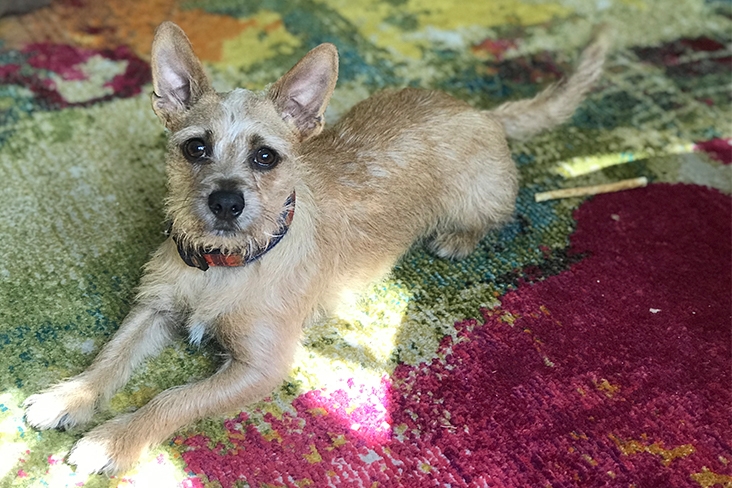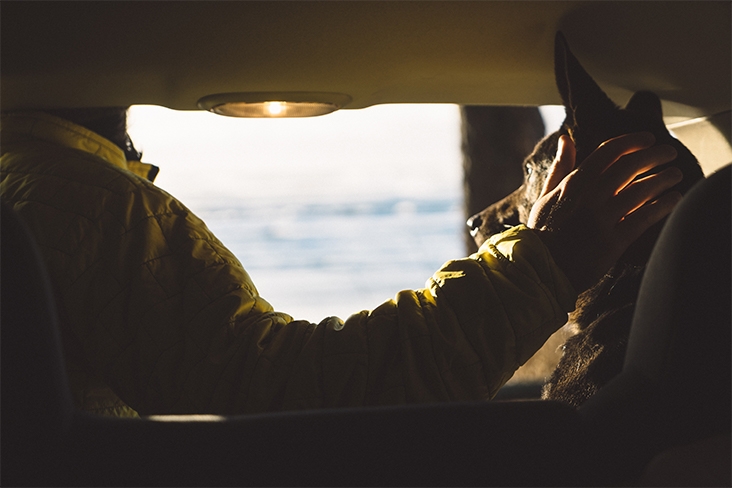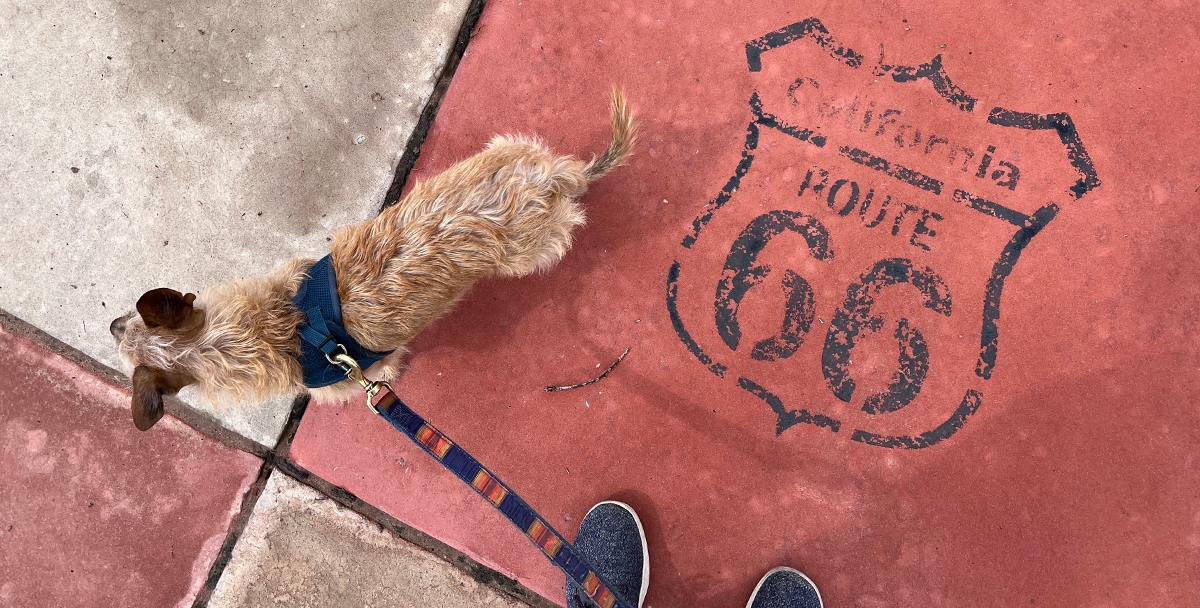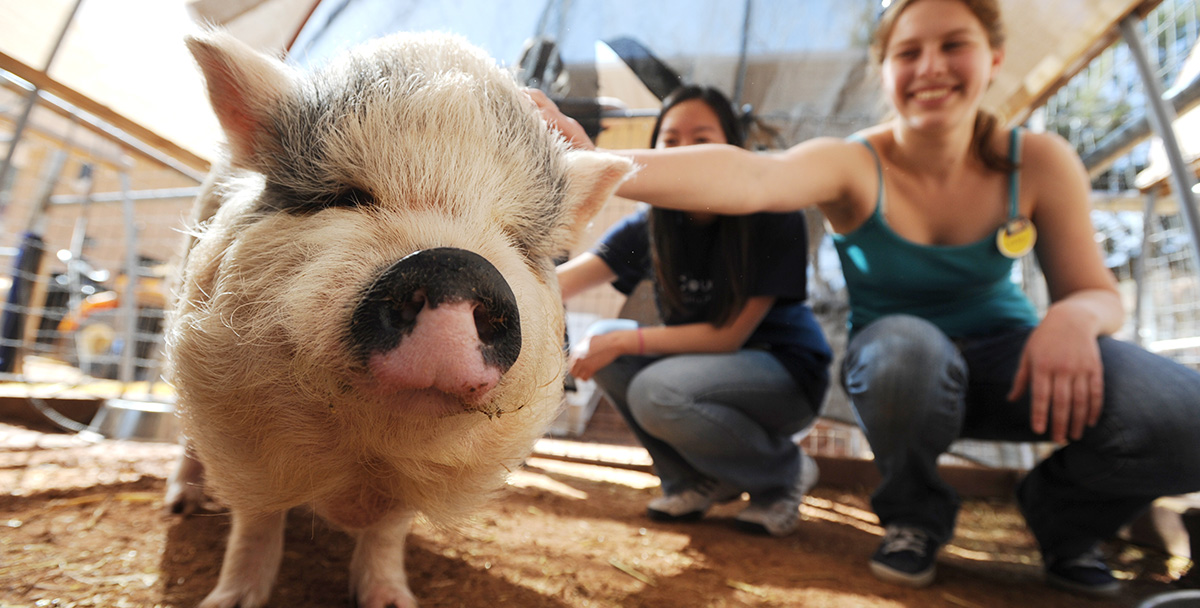As road trips grow in popularity and dog ownership is on the rise, more of us are bringing our canine companions on our travels. We’ve compiled the ultimate guide for everything you need to know about road trips with your dog, from long hauls to short jaunts.
Tip Extra and Other Advice for Hotel Stays With Dogs
By Nicci Micco
If your ride-or-die is a dog, know this: While plenty of hotels accommodate pets, some go over and above – from outfitting rooms with dog beds to never charging pet fees. Here’s how to find the right hotel when road-tripping with your very good boy or girl and what to know to prep for your stay.
Try These Sites and Apps
Petswelcome.com’s road-trip planner lets you create an itinerary with dog-friendly properties all along your route. Or search – and book – hotels through BringFido, narrowing your search by pet policies (including size and number of dogs allowed), room price, additional fees and “bone” ratings determined by customer reviews. Didn’t plan ahead? BringFido’s free app uses your phone’s GPS to find places along your path in real time.
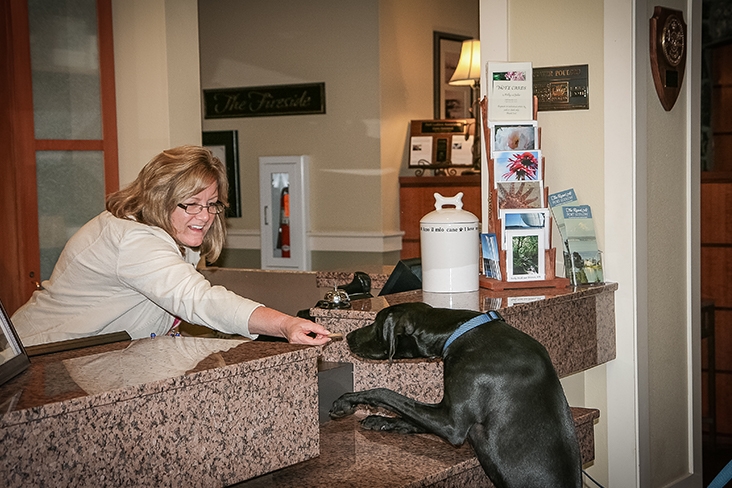
Know These Brands
When it comes to hotel chains, Kimpton® is heads – and tails! – above the rest, welcoming any number of dogs of any size and breed for free and showering them with plush beds, food and water bowls, and mats. Some Kimpton properties even have a dog whose responsibility it is to greet pet guests, or offer a nightly wine reception open to attendance with furry companions.
Aloft®, a Marriott® hotel, offers a special bed, treats, toys and no fees for smaller dogs (up to 40 pounds); many other Marriott properties are dog-friendly too. At Red Roof®, pets always stay free.
Some boutique hotels even center your stay around your dog. The Paw House Inn in West Rutland, Vermont – which charges a $10 nightly fee if you don’t bring a dog – has built-in dog beds and a park with an agility course.
In Kanab, Utah, Best Friends® Roadhouse and Mercantile features rooms with cubbies for snoozing (picture dog houses built into the walls), dog-washing stations, pet-walking services and a fenced dog park area with a splash zone.
To find other hotels like these, check out BringFido’s book Ruff Guide to the United States: 365 of the Best Places To Stay and Play With Your Dog in All 50 States (free, except for shipping). You can also use the “Search Within Results” feature on BringFido’s site to look for things like “dog menu,” which turns up dozens of places that make special meals for dogs.
It’s a good idea to call the specific hotel you’re interested in to confirm that policies stated online are up to date.
Search for Parks, Trails and Patios
If you have a long drive ahead (or behind), it’s worth investigating the area around your potential accommodations. Use Google Maps to look for dog parks, regular parks, trails, restaurants with outdoor seating (call to make sure dogs are allowed), pet stores and even specialty shops, such as pet bakeries, near any hotels you’re considering.
When trekking from Vermont to Western Pennsylvania to visit my parents, my family loves the Aloft Syracuse Inner Harbor in New York because it has a beautiful walking path adjacent to the property and an indoor/outdoor lobby bar. We can grab a nightcap, and our dog usually scores a few head pats from other guests. In the morning, we take a long walk before hitting the road.
Don’t Get Fleeced by Fees – and Leave a Good Tip
It used to be common practice for hotels to charge a refundable deposit in case your dog destroyed something or made a mess. Today, most hotels that charge for pets have switched to nonrefundable fees, which can vary from $10 to $250 or more. It’s up to you as to how much is too much, but it’s doubtful that it costs hundreds of dollars to clean a room after a stay by a well-behaved pup.
“Pet fees are lucrative income for hotels,” says Melissa Halliburton, CEO and founder of BringFido (which lets users filter hotels by pet fees, low to high) and owner of a white 2020 Forester Touring. “In some cases, there may be extra cleaning expenses involved, but those costs don’t justify the larger fees that some hotels charge.” The money also doesn’t go directly to the person who deserves it: the housekeeper cleaning your room.
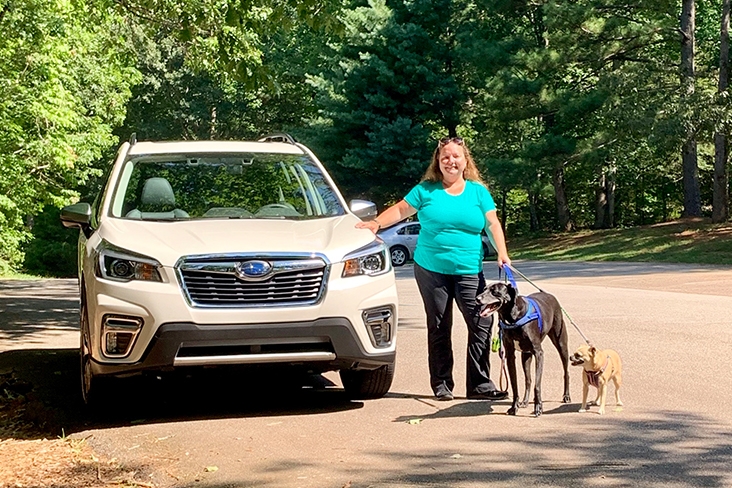
To ensure that the cleaning crew gets their due, tip extra. Ten dollars a day is a good rule of thumb, even if your dog doesn’t leave a trace. “Tipping is a gesture of appreciation not only for cleaning after you but also in getting the room prepared for you and your pet,” says Hana Pevny, innkeeper and owner of Waldo Emerson Inn in Kennebunkport, Maine. Plan ahead by hitting the ATM before your trip so you’re not scrambling at checkout.
Be a Courteous Guest
Wherever you land, follow all of the pet policy rules, often stated in your reservation confirmation email or the release you sign when you check in. If you can’t find the rules, ask at the front desk.
Even if it’s not a rule, don’t leave your dog unattended, which can stoke anxiety and may prompt barking, scratching and/or chewing. Bring plenty of food and treats, a favorite bed or blanket, some toys, and cleaning supplies. “Any major spills and accidents should be cleaned by you,” says Alex Miller, founder and CEO of Upgraded Points™, an online resource for travelers, who often travels with his lab mix, Leo.
And simply be a thoughtful human. Assume not everyone loves dogs as much you do. Don’t let your dog run up to others. If you’re about to board an elevator and people are inside, offer to wait. And (though it should go without saying), always pick up the poop.

8 Gear Recs for Dogs on the Road
By Dan Kricke
Anyone who has gone on a road trip with their dog knows they have to bring along certain essentials: some good snacks, a clean water bowl, ample kibble. But travel pros know the list doesn’t stop there. With the help of the bestest boy I know, my 1-year-old German shepherd mix named Augie, plus the assistance of a certified dog trainer and some other well-traveled dog owners, I’ve compiled a list of gear to make your road trip – and destination – more comfortable for your pup.
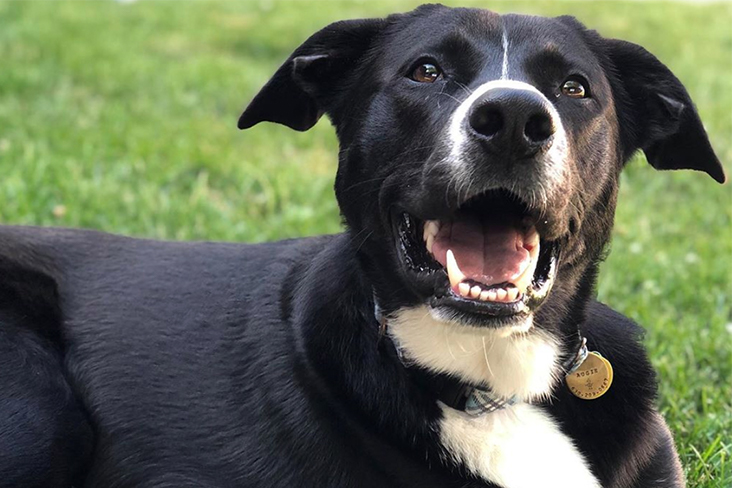
Water Bottle With Attached Bowl
Water is essential to your dog whether or not you’re traveling, but sloshing a bowl around in the vehicle could leave your back seat a waterlogged mess. I’m an advocate of the MalsiPree Dog Water Bottle ($20), a large water bottle with a bowl-like spout. Push and hold a button and water flows freely into the bowl. When your dog’s done drinking, hold down the button while tilting the bottle back to a vertical position; any leftover water will drain back down for later. The MalsiPree, or any of these bottles of a similar style from dog-loving travel-mug-brand Highwave®, is also great on long walks.
Seat Cover With Treads
A back seat cover will help keep fur and paw scuffs off your interior, and a cover with treads on the bottom, such as Active Pets Back Seat Cover ($36), will also help keep your dog from slip sliding around if you have to make sudden stops or sharp turns. The treads are the key here. I’ve used seat covers without treads in the past, and they can be unsteadying to a dog used to hard, flat ground. The treaded version helps Augie stay upright throughout his ride.
Crash-Tested Safety Harness
A quality safety harness is the best option to make sure your pup is secure during your road trip. A truly safe harness will separate the dog from the driver to prevent distracted driving, protect the dog physically from impact (and from injuring other people in the car upon impact), and ensure the dog is comfortable mentally and physically, says Pamela Davis, a certified dog trainer at Urban Pooch® Training and Fitness Center in Chicago.
Davis recommends a crash-tested harness certified by the Center for Pet Safety®, of which only a few options are approved. Davis personally uses the Sleepypod® Pet Harness ($86-$115) for her 5-year-old pit mix, Bea Arfur, which features three points of seatbelt contact and a supportive vest that distributes and disperses force.
Leash With Reflective Stitching
Road trip or not, a leash built with safety in mind is important to have. But some features are doubly important in unfamiliar territory. When I travel with Augie, I use the Black Rhino Double Handle dog leash ($20). It has reflective stitching to make it easier to see at night, a poop bag pouch so I never forget to have bags on hand, and a second handle closer to the collar in case I need to keep a closer grip on my pup in higher traffic areas where he may be uncomfortable.
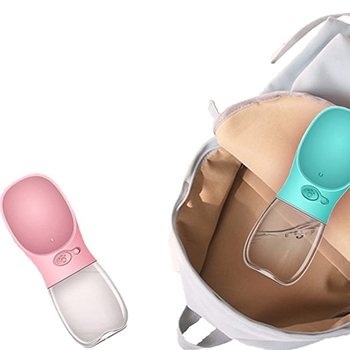
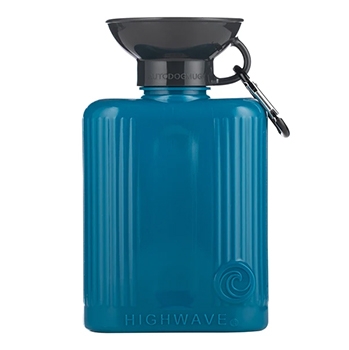
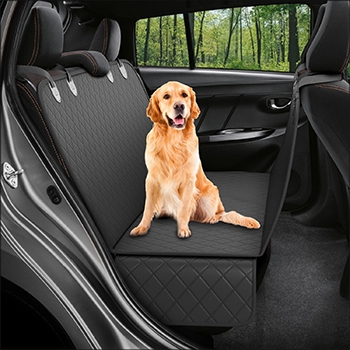
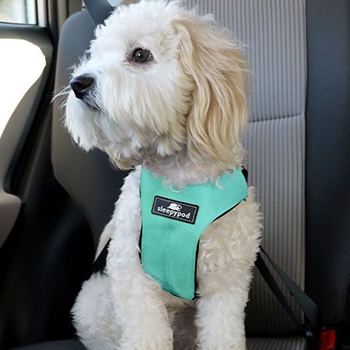
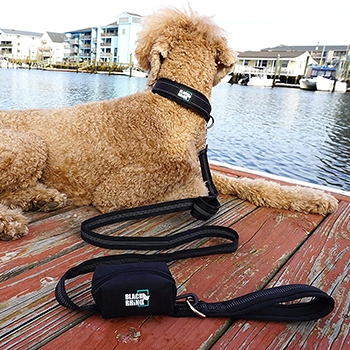
Portable Fan
When packing for a road trip with her 2-year-old, 105-pound Saint Bernard mix, Zeus, Dana Panek of Normal, Illinois, never forgets a portable fan. The Honeywell TurboForce ($24), just 2.6 pounds, is a travel-ready substitute for the house fan Zeus likes to sleep near, to keep him cool and comfortable the whole night through.
Dog-Friendly Fruits and Veggies
Drive editorial director Megan Bungeroth packs car snacks the whole family can share. Her rescue pup, Arthur, a cairn terrier-Chihuahua mix, loves baby carrots – “they help to settle him if he’s wound up,” she says – and he’s happy to share with his favorite humans when they want to pilfer a few. Other fruits and vegetables that are typically approved for dogs include blueberries, bananas, apple slices and celery. But always consult your vet first, and limit portion size to a small handful.
Cleanup Supplies
Dogs can get carsick too. For the times when Augie can’t keep his breakfast down, I keep a bottle of Nature’s Miracle® Stain & Odor Remover ($11 for 32 fluid ounces) handy. For a scent-free option, Bungeroth loves Boxiedog stain and odor remover ($20 for 24 fluid ounces), which she says has worked well on every surface she’s used it on. A stain-removal spray along with a scrub brush, a small spray bottle of water and some paper towels can take care of a mess in a hurry and will also work for any hotel-room accidents.

Finally, if your dog is likely to traipse through mud at your destination or along the way, pack the MudBuster™ Paw Washer ($8-$28), a low-tech, high-efficiency gadget recommended by Andrew DuBeau, a Texas-based Subaru Outback owner who has two rescue whippets, Pixie and Jack.
Travel Rewards, Familiar and New
Once they’ve arrived at the family’s overnight stopping point or vacation destination, Chicago-based Belia Ortega gives her 4-year-old American Staffordshire terrier, Leo, rubber KONG® toys stuffed with wet food, string cheese sticks and other high-value treats. Because Leo receives the same KONG toys at home, getting them at a hotel helps make the destination familiar and relaxing rather than new and scary, Ortega says.
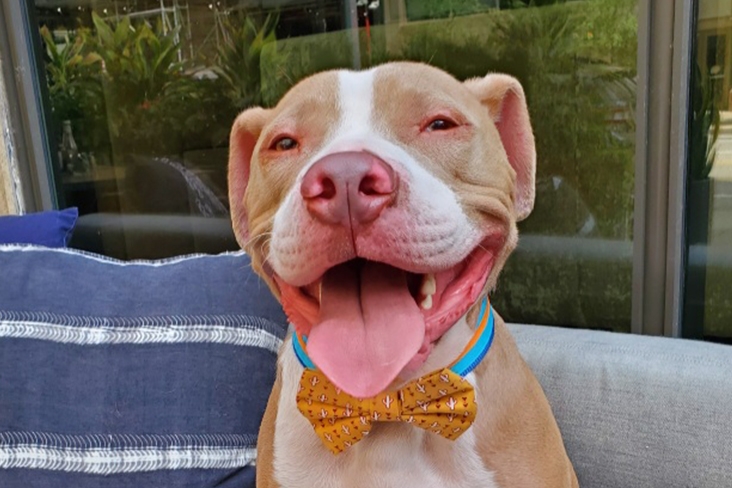
You might also consider packing a brand-new toy or two to encourage stimulation, so that a hotel bedspread doesn’t become a chew toy. A durable puzzle toy, such as the West Paw® Qwizl Treat Toy ($22-$27) can keep a dog entertained for long stretches – so you can relax too.
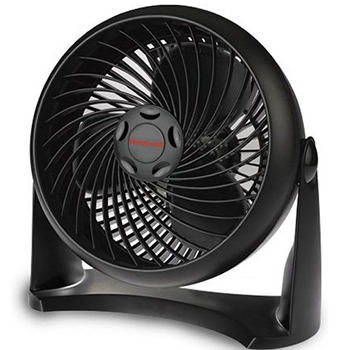
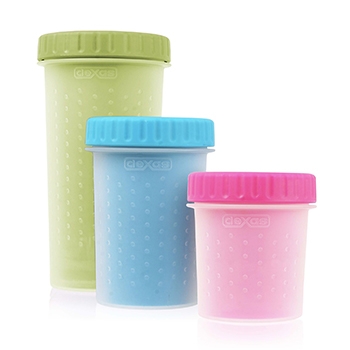

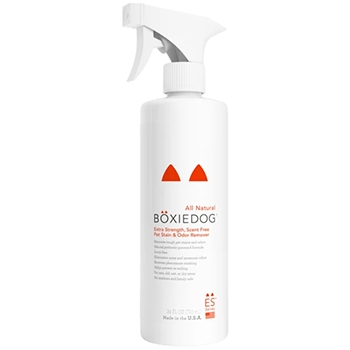

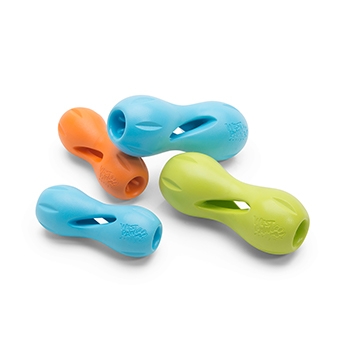
Backcountry Hiking and Camping With Your Dog
By Amanda Loudin
Before he heads out on weekend hiking and camping trips, Mark Holland does a good virtual scouting of the trails he’ll be hitting. Not for himself, but for his 110-pound, 6-year-old mixed-breed dog, Bruno. “Because he’s a large dog, he’s not good on steep climbs, and I learned early on that carrying him up isn’t much fun,” Holland says. “Apps like AllTrails are very useful. They give loads of information about each trail.”
Columbia, Maryland-based Holland, a 28-year old polymer scientist, has been taking Bruno along on his adventures for about four years now. They hit up state parks and campgrounds throughout the mid-Atlantic region, and Bruno even joins Holland in his canoe. They’ve got their system down pat – and, if you’re considering venturing out with your dog into the backcountry, so should you.
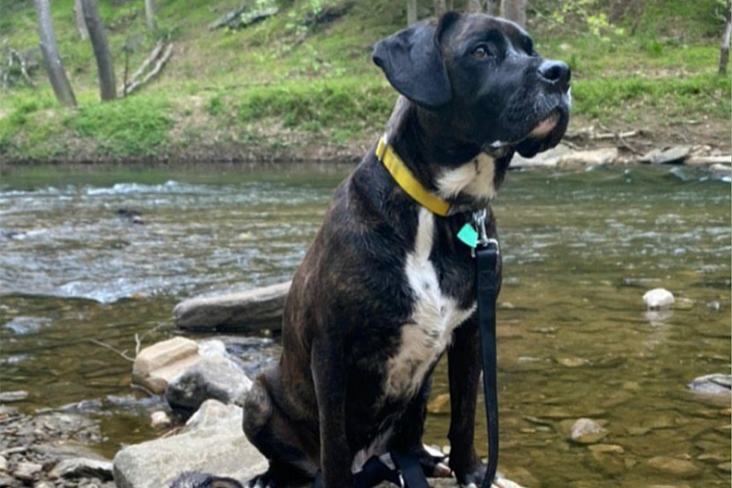
Prep Your Pup
To begin, says Dr. Stephanie Sabshin, a veterinarian with Florida-based Harmony Vet Care, make sure your dog is in shape. “Just like humans, dogs need to build up the endurance to hike long distances,” she says. If the forest trail you’re planning to hike is a 5-mile loop, add mileage gradually to your daily walks until you and your dog hit roughly that distance. If the forecast calls for hot weather, time these training walks – and your eventual hikes – for the cooler hours in the morning or evening, Sabshin adds.
Also know your breed and its potential limitations. “Brachycephalic breeds like bulldogs, pugs and others can have difficulty breathing, which makes it harder to oxygenate and cool,” Sabshin says. “These dogs would not be good candidates for long-distance hikes in the heat.”
Ensure your dog’s vaccines are up to date. Sabshin points to rabies, in particular (a vaccine required by law in all 50 states), since your dog may encounter wildlife on a hike. Other vaccines to consider include Lyme disease, especially if you’re hiking in the Northeast, and leptospirosis. “Lepto is spread in the urine of wild animals and can cause liver failure,” says Sabshin. “It’s also contagious to humans.”
A collar with identifying tags is a must, as is a microchip. If your dog isn’t microchipped, call your vet. Most veterinarians can perform the service, which will likely cost between $30 and $50.
Know Park Rules
First, make sure your dog is welcome. While national parks are generally pet-friendly, each park has its own rules about where dogs can and can’t go. (Learn more on the Pets page of the National Park Service’s website.)
Heather Balogh Rochfort, 38, a freelance writer in Carbondale, Colorado, lived near Rocky Mountain National Park for years but couldn’t take her mixed-breed dog, Tals, hiking there because dogs aren’t allowed on trails. Instead, they found several dog-friendly trails in nearby national forests and Bureau of Land Management areas. Again, rules can vary, so call your local office before you head out.
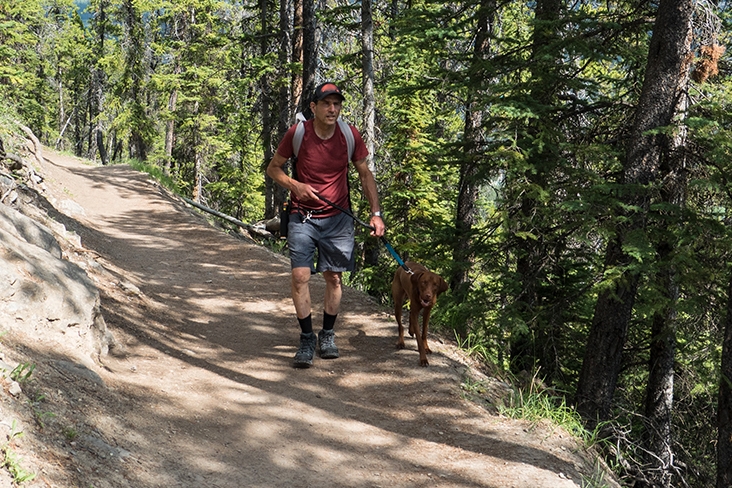
Ask about leash rules too. Kristie Salzmann, public affairs officer for Shoshone National Forest in Wyoming, says that her park welcomes furry friends off leash in certain areas. “When you’re in a developed area of the park, heading out onto a trail or at the trailhead, we ask that your dog remain on a leash,” she says. “Farther out, as long as your dog is under voice control, off leash is fine.” But in forests with steep cliffs or drops, dogs may need to be on leash at all times.
No matter where you hike or camp, make sure to follow Leave No Trace™principles – which means picking up all waste, including your dog’s.
Pack the Right Gear
Like you, your dog is going to get hungry and thirsty out in the wilderness, so bring along adequate food and water. Holland has Bruno carry his own gear in a harness from tactical-gear company OneTigris®.
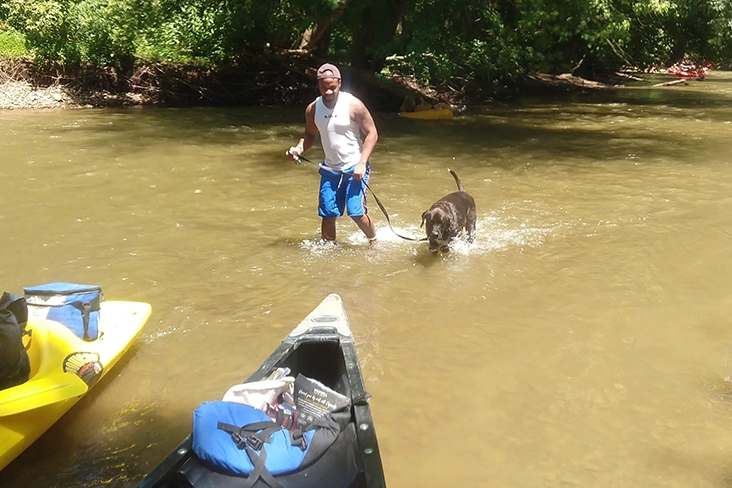
Courtney Schwartz, 34, who hikes and camps in Idaho and Wyoming with her 1-year-old vizsla named Rush, brings a water filter in case she can’t find a clean source. She loves the Sawyer® mini water filtration system ($25 at REI), which she can attach to the included drinking pouch or screw onto a standard water bottle. “It’s very easy to use and does not take up much space at all,” she says. “I can gently squeeze the bag and Rush will drink the water as it comes out of the filter. It also fills up a collapsible dog bowl.”
If you’re camping, consider where your dog will sleep. “We bring a foam sleeping pad for Tals so that she’s off the cold ground in our tent,” says Rochfort.
All of the dog owners bring a sturdy leash for their pets so they have good control of them, and Holland likes to bring a pair of cotton socks for Bruno’s pads in case the ground gets too hot. He uses what he calls the seven-second test: Place the back of your hand on the ground for seven seconds. If it’s too hot for your hand, “it’s too hot for your pup,” he says. On warmer days, he checks every 30 minutes throughout the hike.
Bring basic first-aid supplies, such as this Cinch Tote Pet Care Kit from Subaru, but be mindful that you’re not a vet. “A lot of well-intentioned first-aid attempts can go terribly wrong,” Sabshin says. “Topical ointments are usually quickly licked off and ingested by dogs. Bandages can either be eaten and cause obstruction, or if placed too tight, can cut off blood supply to limbs.” If a bandage gets wet or dirty, it can lead to infection, she adds. “The best advice is to clean wounds with soap and water and bring your dog to a veterinarian for professional care.” (If a wound is large and bleeding, cover it with a clean cloth until you can get to the vet, she says.)
Learn Your Dog’s “I’m Tired” Language
From young to old, dogs depend on you to ensure they’re able to handle the miles you’re asking of them. “Rush is an endurance dog and so has lots of energy,” says Schwartz. “As long as he’s staying ahead of us, we know he’s OK. But once he lays down, he’s finished and we head back.”
Other dogs may not be as adept at signaling fatigue, but there are some signs to watch for. “You want to make sure their gums stay light pink,” Sabshin says. “As gums approach dark pink, [dogs] are getting hot and dehydrated. Red or purple gums are an emergency.” Check gums and the tongue for moisture too. “If they are drying out, the dog is dangerously dehydrated,” Sabshin says. “Remember, dogs can’t sweat. So they are hotter than you are.”
Finally, accept when a dog’s hiking days are behind them. Rochfort’s longtime companion, Tals, is now 15. “Around 12, we noticed her slowing down,” she says. “At 13, her hips became sore and then she tore her ACL, followed by the second one. We had to start leaving her behind. It’s hard. But we’re her humans, so we have to do what’s best for her.”
Tals, however, is still finding adventure at home. “Now, she loves wandering around our backyard while keeping her eye on our toddler, whom she dotes on,” Rochfort says. “She also loves to sit in the sunshine in our front yard.”
